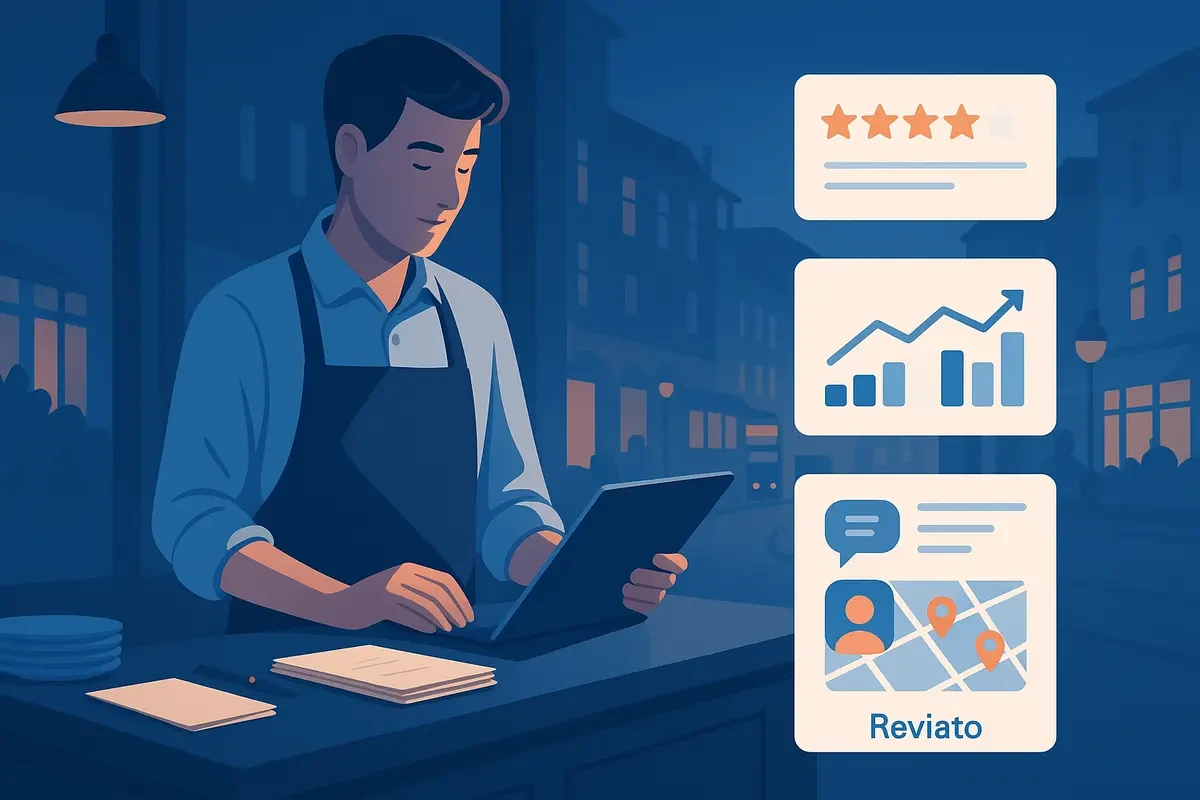Restaurant Review Ops Playbook for Google and TripAdvisor
For independent restaurants and small groups in New York City using Google Maps and TripAdvisor.
Executive TL;DR
- Google‑first if you rely on locals, walk‑ins, and office dayparts.
- TripAdvisor‑first if you rely on tourists, pre‑theater covers, concierge traffic.
- Balanced 60/40 if your mix shifts by season or neighborhood.
- Fix the two universal pain points this week: price transparency (fees, auto‑gratuity) and service attentiveness (host and FOH responsiveness). Update menus and bills; re‑train for mid‑meal check‑ins.
- Operate on a clock: time‑boxed blocks (20 to 40 minutes) with clear ownership, templates, and six simple KPIs.
Core Principles
Freshness wins
New photos, accurate hours, and quick owner replies drive rank and conversion.
Specificity sells
Name menu items, neighborhoods, pre‑theater timing, access (subway lines), and dietary tags.
Reply like a human
Offer context, empathy, and a clear fix. Avoid boilerplate.
One truth for prices and fees
Menus, website, Google menu, TripAdvisor description, and printed checks must match.
Measure weekly, adjust monthly
Treat ranking and review pace as controllable metrics.
Platform Playbooks
A) Google‑First Playbook (locals and walk‑ins)
Goal: Rank in the Local Pack for your primary cuisine + neighborhood queries and convert via calls/directions.
Cadence & Tasks
Daily (15 to 20 minutes)
- Respond to all new reviews within 24 hours (aim under 12 hours).
- Confirm hours/special hours (events, holidays).
Weekly (30 to 40 minutes)
- Upload 3 to 6 fresh photos (interior, exterior, top three dishes, a drink, staff in action).
- Post a Google Update (special, prix fixe, pre‑theater seatings, neighborhood event tie‑in).
- Spot‑check listing accuracy (categories, attributes like outdoor seating, accessibility).
Monthly (45 minutes)
- Menu audit: price/fees alignment across menu/website/Google.
- Competitor check: search your top two queries; screenshot top five.
Response Template (positive)
“Thank you, [Name]. Glad you loved the [dish]. We’ll share your note with [server/chef]. See you before [event/neighborhood hook].”
Response Template (negative)
“I’m sorry for the [issue] you experienced on [date/service]. That’s on us. We’ve [specific fix] and I’d like to make this right. Please email me at [name@] with the name on your booking so I can help personally. [GM Name]”
B) TripAdvisor‑First Playbook (tourists and planners)
Goal: Improve category rank and convert planners scanning long‑form details and photos into bookings.
Cadence & Tasks
Daily (15 to 20 minutes)
- Respond to all new reviews; include context (pre‑theater timing, subway access, kid‑friendly seating).
Weekly (30 to 40 minutes)
- Update FAQs (dietary options, pre‑theater set times, group policies).
- Competitor rank log: screenshot top ten in your category; note shifts.
Monthly (60 minutes)
- Photo sprint: 10 to 15 high‑quality images with guests’ POV (host stand sightline, booth spacing, bar seats, dessert).
- Badge maintenance: track eligibility requirements (rating, recency, volume) and set next‑month targets.
Response Template (planner‑friendly)
“Thanks, [Name]. For pre‑theater at [venue], we recommend [time window]; mains reach the table in [X minutes]. We have [dietary] menus. Just let us know in the notes.”
C) Balanced 60/40 Play
- 60% Google / 40% TripAdvisor time split.
- Assign clear owners: GM (Google), Floor Lead (TripAdvisor), Host/MA (photo/content), Chef (menu accuracy).
- Review KPIs weekly; rotate a 20‑minute cross‑training huddle each week.

Photo & Content Standards (Both Platforms)
- People + Plates: 50/50 mix; candid staff moments signal hospitality.
- Angles that convert: Exterior (recognition), host stand, best two‑tops, restroom corridor (cleanliness cue), top five dishes, dessert, bar.
- Metadata: Alt text/captions that name the dish, neighborhood, proximity to [landmark/subway].
- Seasonality: Replace anything older than 30 days; add holiday/event tie‑ins.
Training: Two Universal Fixes
Price transparency
- Match prices and fees across menu, website, Google, TripAdvisor, and printed checks.
- At the host stand, use a 10-second script to disclose time limits and any large-party fee at seating.
Service attentiveness
- Verify every reservation with a two-point check: platform and name spelling.
- Do mid-meal check-ins 3 to 4 minutes after food lands; the server shares their name and one suggestion.
Six KPIs to Track Weekly
- Local Pack Rank (top 3? yes/no) for two priority queries.
- Google response time (median hours; target under 12 hours).
- New Google Photos This Week (target ≥3).
- TripAdvisor Category Rank (position & delta vs last week).
- TripAdvisor response time (median hours; target under 24 hours).
- Review Pace (≥1 new review/week/platform/location).
Tools: a simple spreadsheet; data pulled each Monday before service.
90‑Day Ramp (Owner View)
- Days 1 to 7: Fix fees and price parity, write reply templates, collect 30 fresh photos, clean up hours and categories.
- Days 8 to 30: Establish daily and weekly cadences; drive the first 10 fresh reviews; post four Google updates.
- Days 31 to 60: Launch the monthly photo sprint; secure first TripAdvisor badge eligibility; stabilize response times below targets.
- Days 61 to 90: Push into the Local Pack for one or more queries; maintain weekly review pace; review staffing vs peaks.
Download the Weekly Checklist PDF
- Print-ready checklist so managers can spot gaps before pre-shift.
- Includes the Google, TripAdvisor, and Ops hygiene blocks from this guide.
- Track who downloaded it via a unique Vault link for each email.
We’ll verify your email to keep Vault downloads secure. No spam.